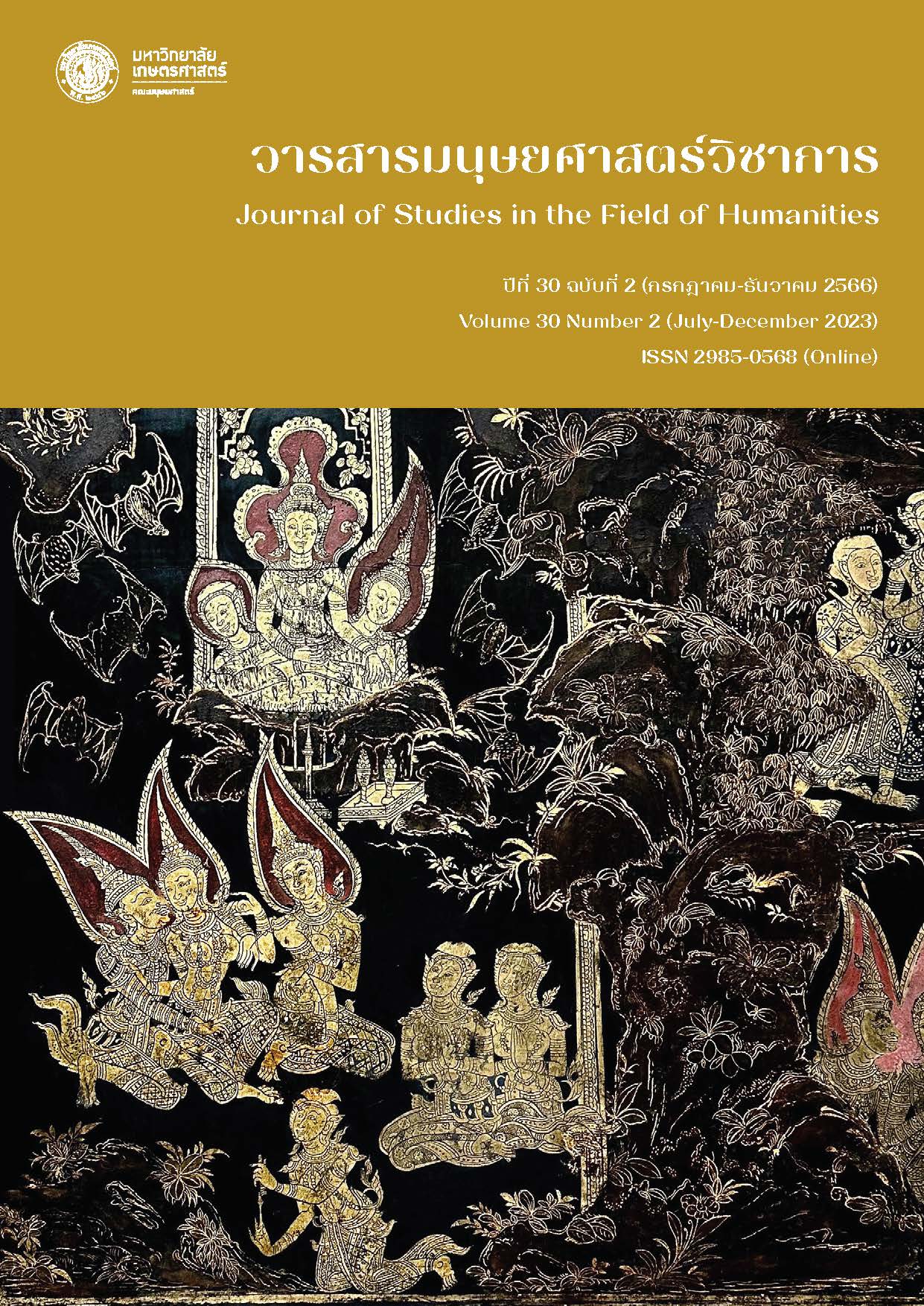The Art of Epithet in the Kumārasambhava, Sanskrit Poetry of Kālidāsa
Main Article Content
Abstract
The purpose of this article is to study the literary art of Kālidāsa, specifically the art of epithet, with Cantos 1-8 of Sanskrit poetry titled Kumārasambhava as the main resources for data collection. The research found that Kālidāsa used synonyms for the Lord Shiva’s names that can be divided into three types: 1. the main word of ancient names; 2. the names that the poet himself had made; 3. the various meaningful names related to the story. The third type can be divided further into 4 groups: 3.1 the general well-known name; 3.2 the names that show greatness; 3.3 the names that represent the identity of the deity; and 3.4 the names corresponding to the events that the poet was telling. For the goddess Pārvatī’s, the poet used epithets with characteristics appropriate for the story, which can be divided into 3 groups: 1. the names corresponding to the role of the daughter of God Himawat; 2. the names corresponding to the role of the perfect ascetic; and 3. the names corresponding to the role of a noble or virtuous woman. The poet also used the art of epithet with God Himawat’s names, which can be divided into 3 groups: 1. the general words that mean “a mountain”; 2. the words that directly refers to the “Himālayan mountain”; and 3. the words that clearly indicates the deity’s role as “the king of the mountains”.
Article Details

This work is licensed under a Creative Commons Attribution-NonCommercial-NoDerivatives 4.0 International License.
References
จิรายุ นพวงศ์, หม่อมหลวง. (2535). ประวัติวรรณคดีสันสกฤต. ใน จิรายุนิพนธ์. (น. 87-114). คณะอักษรศาสตร์ จุฬาลงกรณ์มหาวิทยาลัย.
บุญเลิศ วิวรรณ์. (2553). การวิเคราะห์พระสมัญญานามของพระพุทธเจ้าในคัมภีร์พระพุทธศาสนาและในวรรณคดีพระพุทธศาสนา (วิทยานิพนธ์ดุษฎีบัณฑิต สาขาวิชาภาษาไทย). หาวิทยาลัยเกษตรศาสตร์, กรุงเทพฯ.
บุญเลิศ วิวรรณ์. (2562). นันโทปนันทสูตรคำหลวง: ความพิเศษ ความหมาย ความเชื่อ แห่งคำเรียกชื่อพญานาค. ดำรงวิชาการ, 18(1), 151-172.
ปานทิพย์ มหาไตรภพ. (2545). นามสกุลพระราชทานในพระบาทสมเด็จพระมงกุฎเกล้าเจ้าอยู่หัว: การวิเคราะห์ทางอรรถศาสตร์ชาติพันธุ์ (วิทยานิพนธ์มหาบัณฑิต สาขาวิชาภาษาศาสตร์). จุฬาลงกรณ์มหาวิทยาลัย, กรุงเทพฯ.
พระมหากวีศักดิ์ วาปีกุลเศรษฐ์. (2563). วรรณกรรมบาลีเรื่องสมันตกูฏวัณณนา: การศึกษาวรรณศิลป์และสังคม (วิทยานิพนธ์มหาบัณฑิต สาขาวิชาจารึกภาษาไทยและภาษาตะวันออก). มหาวิทยาลัยศิลปากร, นครปฐม.
ราชบัณฑิตยสถาน. (2556). พจนานุกรมฉบับราชบัณฑิตยสถาน พ.ศ. 2554. กรุงเทพฯ: ราชบัณฑิตยสถาน.
Apte, V.S. (1890). The Practical Sanskrit-English Dictionary. Retrieved September 20, 2012, from https://dsal.uchicago.edu/dictionaries/apte/.
Bandyopadhyay, Pratap. (1986). Did Kalidasa Complete the Kumarasambhava?. Journal of the American Oriental Society, 106(3). 559-564.
Griffith, R. T. H. (1889). The Hymns of the Rigveda (Vol. I). Benares: E.J. Lazarus.
Kale, M. R. (1917). Kalidasa’s Kumarasambhava cantos I-VIII (7th Ed.). Delhi: Motilal Banarsidass.
Kale, M. R. (2016). A Higher Sanskrit Grammar: for The Use of School and College Students (11th Reprint). Delhi: Motilal Banarsidass.
Keith, A.B. (1920). A History of Sanskrit Literature. Oxford: Great Britain.
Mani, V. (1975). Puranic Encyclopedia, A Comprehensive Dictionary with Special Reference to the Epic and Puranic Literature. Delhi: Motilal Banarsidass.
Ryder, A. W. (1928). Kalidasa Translations of Shakuntala and Other Works. London: J.M. Dent & Sons Ltd.
Shar, P. (1990). Shri Vishnudharmottara (A Text on Ancient Indian Arts). Baroda: The new order book co.
Williams, M. (1899). Sanskrit-English Dictionary. Retrieved September 20, 2012, from https://www.sanskrit-lexicon.uni-koeln.de/scans/MWScan/2020/web/webtc2/index.php.
Wongsathit, U. (2012). The Ksatriyas of Ancient Cambodia. in Proceeding of the 8th International Conference on Southeast Asian Cultural Values, 6-7 December 2012, Angkor entury Hotel, Siem Reap City, Cambodia. 70-85.


